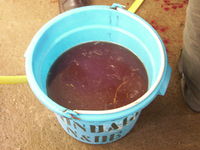Difference between revisions of "Colic Diagnosis - Naso-gastric Intubation"
| Line 1: | Line 1: | ||
{{review}} | {{review}} | ||
| − | [[Nasogastric intubation in the horse|Passing a Naso-Gastric Tube]] is useful both diagnostically and therapeutically. It should be performed in any patient with colic in order to determine if gastric distention is present and to relieve it. Therapeutically, gastric decompression is important, since horses are unable to vomit.Fluid is refluxed from the stomach, and any more than 2 litres of fluid is considered to be significant and indicates that surgery is necessary. Increased fluid is generally a result of backing up of fluid through the intestinal tract, due to a downstream obstruction. More than 2 litres of nasogastric reflux can be caused by a primary disorder of the small intestine or stomach. Horses with anterior enteritis have large volumes (10 to 20 litres) of reflux. Large colon obstructions such as a torsion can produce reflux due to secondary ileus and compression of the small intestine which prevents gastric emptying. The quantity, smell, content, and pH of the fluid should always be assessed. Blood-tinged, foul-smelling reflux indicates a severe anterior enteritis or a strangulating small intestinal obstruction. In these cases, gastric fluid will continue to build up and so the tube should be left in place to prevent a fatal gastric rupture. | + | [[Nasogastric intubation in the horse|Passing a Naso-Gastric Tube]] is useful both diagnostically and therapeutically. It should be performed in any patient with colic in order to determine if [[Gastric Dilation and Rupture - Horse|gastric distention]] is present and to relieve it. Therapeutically, gastric decompression is important, since horses are unable to vomit.Fluid is refluxed from the stomach, and any more than 2 litres of fluid is considered to be significant and indicates that surgery is necessary. Increased fluid is generally a result of backing up of fluid through the intestinal tract, due to a downstream obstruction. More than 2 litres of nasogastric reflux can be caused by a primary disorder of the small intestine or stomach. Horses with anterior enteritis have large volumes (10 to 20 litres) of reflux. Large colon obstructions such as a torsion can produce reflux due to secondary ileus and compression of the small intestine which prevents gastric emptying. The quantity, smell, content, and pH of the fluid should always be assessed. Blood-tinged, foul-smelling reflux indicates a severe anterior enteritis or a strangulating small intestinal obstruction. In these cases, gastric fluid will continue to build up and so the tube should be left in place to prevent a fatal gastric rupture. |
[[File:Haemorrhagic Reflux.jpg|thumb|200px|right| Picture of a large volume of blood-tinged reflux from a horse with anterior enteritis(Courtesy of Potter K, SPANA)]] | [[File:Haemorrhagic Reflux.jpg|thumb|200px|right| Picture of a large volume of blood-tinged reflux from a horse with anterior enteritis(Courtesy of Potter K, SPANA)]] | ||
Latest revision as of 10:15, 8 October 2010
| This article has been peer reviewed but is awaiting expert review. If you would like to help with this, please see more information about expert reviewing. |
Passing a Naso-Gastric Tube is useful both diagnostically and therapeutically. It should be performed in any patient with colic in order to determine if gastric distention is present and to relieve it. Therapeutically, gastric decompression is important, since horses are unable to vomit.Fluid is refluxed from the stomach, and any more than 2 litres of fluid is considered to be significant and indicates that surgery is necessary. Increased fluid is generally a result of backing up of fluid through the intestinal tract, due to a downstream obstruction. More than 2 litres of nasogastric reflux can be caused by a primary disorder of the small intestine or stomach. Horses with anterior enteritis have large volumes (10 to 20 litres) of reflux. Large colon obstructions such as a torsion can produce reflux due to secondary ileus and compression of the small intestine which prevents gastric emptying. The quantity, smell, content, and pH of the fluid should always be assessed. Blood-tinged, foul-smelling reflux indicates a severe anterior enteritis or a strangulating small intestinal obstruction. In these cases, gastric fluid will continue to build up and so the tube should be left in place to prevent a fatal gastric rupture.
References
- Edwards B. (2009), Diagnosis and Pathophysiology of Intestinal Obstruction, in Equine Gastroenterology courtesy of the University of Liverpool, pp 55- 63
- Meuller E, Moore J. N, (2008) Classification and Pathophysiology of Colic, Gastrointestinal Emergencies and Other Causes of Colic, in Equine Emergencies- Treatments and Procedures, 3rd Edition, Eds Orsini J. A, Divers T.J, Saunders Elsevier, pp 109-110
- Rose R.J, Hodgson D.R (2000) Examination of the Alimentary Tract, Alimentary Tract, Manual of Equine Practice, 2nd Edition, Saunders Elsevier, pp 294
